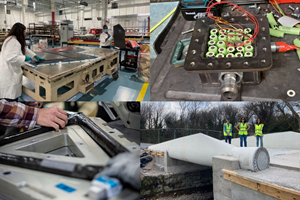What's old is new again
Happy New Year. As it does for many of you, the December-to-January jump heralds for us at HPC a renewal of sorts as we delve into a fresh collection of stories and welcome some new contributing writers. Among the new names you’ll see in our bylines, one that might be familiar is Chris Red. The editor and VP of market
Share
Read Next
Happy New Year. As it does for many of you, the December-to-January jump heralds for us at HPC a renewal of sorts as we delve into a fresh collection of stories and welcome some new contributing writers. Among the new names you’ll see in our bylines, one that might be familiar is Chris Red. The editor and VP of market research at Composite Market Reports (Gilbert, Ariz.), Chris has been involved in the composites industry for many years and is a highly respected and familiar face at industry conferences and seminars around the world. His specialty, market and technology analysis, becomes a strength for HPC in 2008. Chris will write a series of “Market Outlook” features, covering sports equipment this month (see “Market Outlook” under “Related Content,” at left), and in subsequent months he will explore advanced composites use in rotorcraft, business and experimental aircraft, commercial aircraft and jet engines.
Boeing uncertainty, carbon fiber’s future
Just before the close of 2007, The Boeing Co. hosted one of its quarterly conference calls/Webcasts to provide an update on the status of the 787 Dreamliner. As you know, after what had been an apparently smooth-running, glitch-free production process for the 787, Boeing announced in mid-October that the first 787 was not coming together as planned, would not make its first flight in the fall as planned and would not be delivered to All Nippon Airways in May 2008 as planned. Further, Mike Bair, manager of the 787 program, was unseated and replaced by Boeing veteran Pat Shanahan. Along, then, came the mid-December conference call, ahead of which there was some speculation in the aerospace industry that Boeing would announce further 787 delays. What we heard, however, was a steadfast declaration by Shanahan and Boeing executive VP Scott Carson that the Dreamliner would, indeed, power up in January, fly by March, and land in All Nippon’s inbox before the end of 2008.
Questions during this conference call came from a variety of high-profile types, including investment bankers and mass media journalists, and nearly all betrayed some skepticism that Boeing could meet the new schedule. Further concern seemed to revolve around two additional factors: Boeing has planned, and continues to plan, to build 109 787s in 2009 — nine planes a month — followed by a ramp-up to an eye-popping 14 planes a month in 2010. All of this is necessary so that Boeing can start nibbling away at the 761 Dreamliner orders now on its books.
Plans like this have a ripple effect throughout the composites industry: Toray is in talks with Boeing to extend its carbon fiber supply contract for the 787 to meet the 2010 demand, which means that Toray would have to expand facilities and add capacity at plants in Washington State, Alabama and Japan, which means that the closely watched carbon fiber supply/demand equation very likely will change … again.
The early ripples were felt in Washington, D.C. as well, at COMPOSITESWORLD’s Carbon Fiber 2007 Conference (Dec. 5-7, 2007; see “Carbon Fiber 2007 ….” under “Related Content”). The question before conference attendees was deceptively simple: Given the spate of recent announcements of carbon fiber production expansions, will there be enough to go around in the next decade? There was no consensus. Some looked at data presented at the conference and saw supply exceeding demand consistently. Doubters, citing pent-up demand caused by the shortage, declared that there will never be enough carbon fiber to meet every market’s need. The truth is no one can know for sure. Welcome to 2008.
Related Content
The real value of CompositesWorld
Will CW editor-in-chief Jeff Sloan soon be replaced by ChatGPT? Probably not before he retires, but it’s fun to consider the possibility.
Read MoreAs 2023 begins, a look back at trending CW topics in 2022
With 2022 now behind us, CW’s editor-in-chief Jeff Sloan takes a look at the CW stories last year that received the most reader attention.
Read MoreRemembering Don Adams
When one thinks of composites test methods, one thinks of Don Adams. Don passed away at the end of 2022. We remember him here.
Read MoreA return to JEC World
CW editor-in-chief Scott Francis reflects on the ways in which the composites industry has changed and also stayed the same based on observations from this year’s JEC World.
Read MoreRead Next
All-recycled, needle-punched nonwoven CFRP slashes carbon footprint of Formula 2 seat
Dallara and Tenowo collaborate to produce a race-ready Formula 2 seat using recycled carbon fiber, reducing CO2 emissions by 97.5% compared to virgin materials.
Read MoreVIDEO: High-volume processing for fiberglass components
Cannon Ergos, a company specializing in high-ton presses and equipment for composites fabrication and plastics processing, displayed automotive and industrial components at CAMX 2024.
Read MorePlant tour: Daher Shap’in TechCenter and composites production plant, Saint-Aignan-de-Grandlieu, France
Co-located R&D and production advance OOA thermosets, thermoplastics, welding, recycling and digital technologies for faster processing and certification of lighter, more sustainable composites.
Read More






















